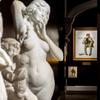Revolutionaries: The Impressionists and Post-Impressionists
- November 29, 2022 12:34
Modern art was born in the mid-19th century, and Impressionism was its catalyst. Challenging the traditional classical ideals of representation championed by the French Academy, the Impressionists and their successors reflected he dramatic political, industrial and social changes of the mid-19th century, and helped the world visualize a new version of contemporary life. Please enjoy this journey through this artistic revolution unlike anything since the Italian Renaissance.
THE BARBIZON SCHOOL
First, we must start at the beginning. In the 1830s, what became known as the Barbizon School was a casual group of painters who shared a passion for painting outdoors en plein air — a revolutionary idea during an age when studio painting and Academic art was at its height. Their goal was to capture a more realistic and natural representation of the French landscape, while also challenging the existing hierarchy of painting subjects promoted by the French Academy. Thanks to the work of the Barbizon painters, the landscape became respected as a subject in its own right.
Important artists: Theodore Rousseau, Camille Corot, Jean-François Millet and Eugène Boudin
IMPRESSIONISM
Next, Impressionism supplanted the prevailing conceptual approach to art with a perceptual one, focusing on the artist’s actual visual experience rather than artistic ideals. Impressionists developed a new painterly technique that was best suited to capturing the transitory effects of nature and modern life. Light, loose brushwork and a vibrant palette were adopted in order to best depict the optical effects of light, the play of the sun’s rays and the transient effects of weather. Artists were now interpreting the fleeting atmospheric changes that were right before them.
Important artists: Édouard Manet, Claude Monet, Pierre-Auguste Renoir, Berthe Morisot, Edgar Degas and Camille Pissarro
AMERICAN IMPRESSIONISM
Quickly following the European movement, American Impressionism was born from the generation of painters who traveled to France after the American Civil War to study the popular Impressionistic style. Like the French Impressionists, they depicted scenes of everyday life using natural light, rapid brushwork and a brilliant palette. Unlike the French, however, they were more concerned with painting places that offered a positive sense of national identity. They captured both the natural and urban landscapes with their new style, breaking with the traditional expectations of academic art to usher in the first modern art movement in America.
Important Artists: William Merritt Chase, Childe Hassam, John Henry Twachtman and John Singer Sargent
POST-IMPRESSIONISM
Two decades following the birth of Impressionism, the Post-Impressionists emerged as a new generation of artists working in a wide range of distinctive and experimental styles. Both inspired by Impressionism and rebelling against its limitations, they pioneered a new movement that generally preferred a subjective interpretation over a realistic one. Above all, the Post-Impressionists made manifest the inner mind or soul of the artist through a vivid use of color and a subjective interpretation of a scene.
Important Artists: Georges Seurat, Théo van Rysselberghe, Henri Lebasque, Vincent van Gogh and Paul Gauguin
FAVISM
Emerging in the later years of Post-Impressionism in the early 20th century, Fauvism was a radical movement of loosely connected artists who above all championed the separation of color from its traditional, natural forms. Instead, they used vivid hues to convey the emotional state of the artist, as well as the psychological impact of a scene. These artists created flattened, simplified scenes filled with highly saturated color in order to convey a strong and immediate visual impact. Led by Henri Matisse, the group also included Maurice de Vlaminck, Kees van Dongen and Raoul Dufy.
Important Artists: Henri Matisse, Maurice de Vlaminck, Kees van Dongen and Raoul Dufy
NEO-IMPRESSIONISM
Lastly, the Neo-Impressionists, known for their use of the Pointillist and Divisionist techniques, emerged at the end of the 19th century and remain one of the most distinctive artistic movements in Western history. Unlike the Impressionists who recorded nature and the elusive qualities of light with spontaneity, Neo-Impressionists approached optical phenomena scientifically and relied on color theory to achieve their desired visual effects.
Important Artist: Georges Seurat, Henri Martin




















31100x100_c.jpg)